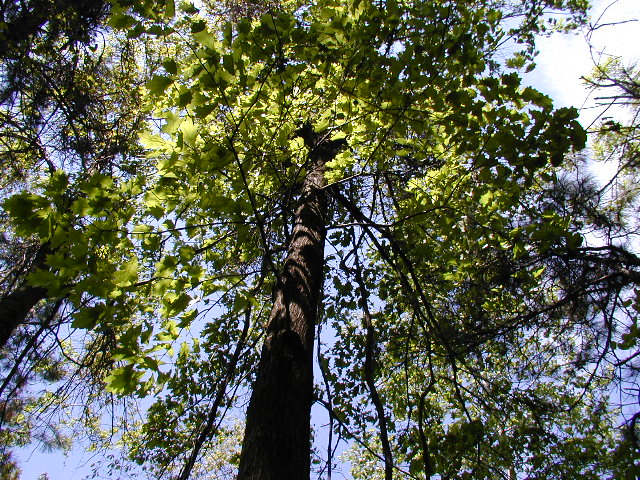 The woods around us are showing the off the abundances and leafing orders of our local tree species. They are letting us, for a short period of time, see the trees instead of just the forest! They are also reminding us of a century and a half of their ecological history!
The woods around us are showing the off the abundances and leafing orders of our local tree species. They are letting us, for a short period of time, see the trees instead of just the forest! They are also reminding us of a century and a half of their ecological history!
A couple of weeks ago our forested hillsides all had a reddish hue from all of the flowers on the incredibly abundant red maples (photo by D. Sillman). Those flowers have now faded and fallen and the leaf buds of all of the species of maples are straining at their encasements and hinting at the green they have inside. The silver maple at the bottom of my field just opened up its leaves three days ago and the red maples closer to my house are just starting to reveal their new, red and green young leaves.
The apple, crabapple, pear and cherry trees have unfolded their light green leaves. Roadsides and hillsides are flushing green especially with the abundance of black cherry trees that characterize this southern edge of the “Allegheny Hardwood” forest mix. These sun-loving black cherries (along with all of those red maples!) were among the first species to recolonize the clear cut forest sites all across Western Pennsylvania. This forest mix grew rapidly but is not made up of very long-lived tree species. The first black cherries that grew in this forest succession sequence will be reaching the end of their expected life spans within the next couple of decades. What will these forests look like when all of those trees are gone?
 Another major tree of these forests is the red oak (picture at left by D. Sillman of a fine summer-time specimen out on our Campus Nature Trail). It responded to the clear cut forest destruction by sprouting new trunks from the roots of the downed trees. Often these trunks are grow in pairs, so when you see a double trunked red oak you are looking at a tree that rebounded from the ecological devastation of the late nineteenth and early twentieth centuries, the devastation that Gifford Pinchot called “an orgy of forest destruction.” Red oaks are some weeks away from unfolding their leaves. Their buds are starting to swell, but the trees are still in their winter form.
Another major tree of these forests is the red oak (picture at left by D. Sillman of a fine summer-time specimen out on our Campus Nature Trail). It responded to the clear cut forest destruction by sprouting new trunks from the roots of the downed trees. Often these trunks are grow in pairs, so when you see a double trunked red oak you are looking at a tree that rebounded from the ecological devastation of the late nineteenth and early twentieth centuries, the devastation that Gifford Pinchot called “an orgy of forest destruction.” Red oaks are some weeks away from unfolding their leaves. Their buds are starting to swell, but the trees are still in their winter form.
My two young red oaks out in my back yard are fine looking pole trees of twelve and twenty feet. They both held their old leaves through most of the winter and have only just recently shed them. I wonder if these old leaves that cling on these trees help to protect the new leaf buds? Or, do these tough, old, oak leaves weather down a bit while they up hanging in the wind and snow and rain and then decompose more rapidly when they finally get added to litter layer of the forest floor in the spring? Beech trees (another very tough leaved species!) keep their leaves through the winter, too. It would be interesting to look at this more closely!
That we have forests around us at all after that century-plus ago, uncontrolled assault on our ecosystems is a credit to the nutrient richness of our soils, the abundance of our rainfall, and to the ecological reservoirs of plant species (especially trees!) to fuel a robust successional recovery. The forest we see around us now is very different than the forest that had evolved here over the millennia since the retreat of the last Ice Age’s glaciers. These forests are an unprecedented, broad scale experiment whose ultimate fate is not at all known.
 And finally, along many waterways and in many tended yards, willow trees have been in light green leaf for a couple of weeks now (photo from Pixabay by Kiwi). I have been watching set of willows that grow along my driving route to campus from my home. They are starting to fill in their dropping branches with denser and denser arrays of leaves, and are slowly becoming more and more solid to the eye.
And finally, along many waterways and in many tended yards, willow trees have been in light green leaf for a couple of weeks now (photo from Pixabay by Kiwi). I have been watching set of willows that grow along my driving route to campus from my home. They are starting to fill in their dropping branches with denser and denser arrays of leaves, and are slowly becoming more and more solid to the eye.
Looking out the window over my writing desk I still see the dark, bare branches of the black locust trees and the oaks. Spring still has quite a bit of work to do to get us up to the green of summer!
